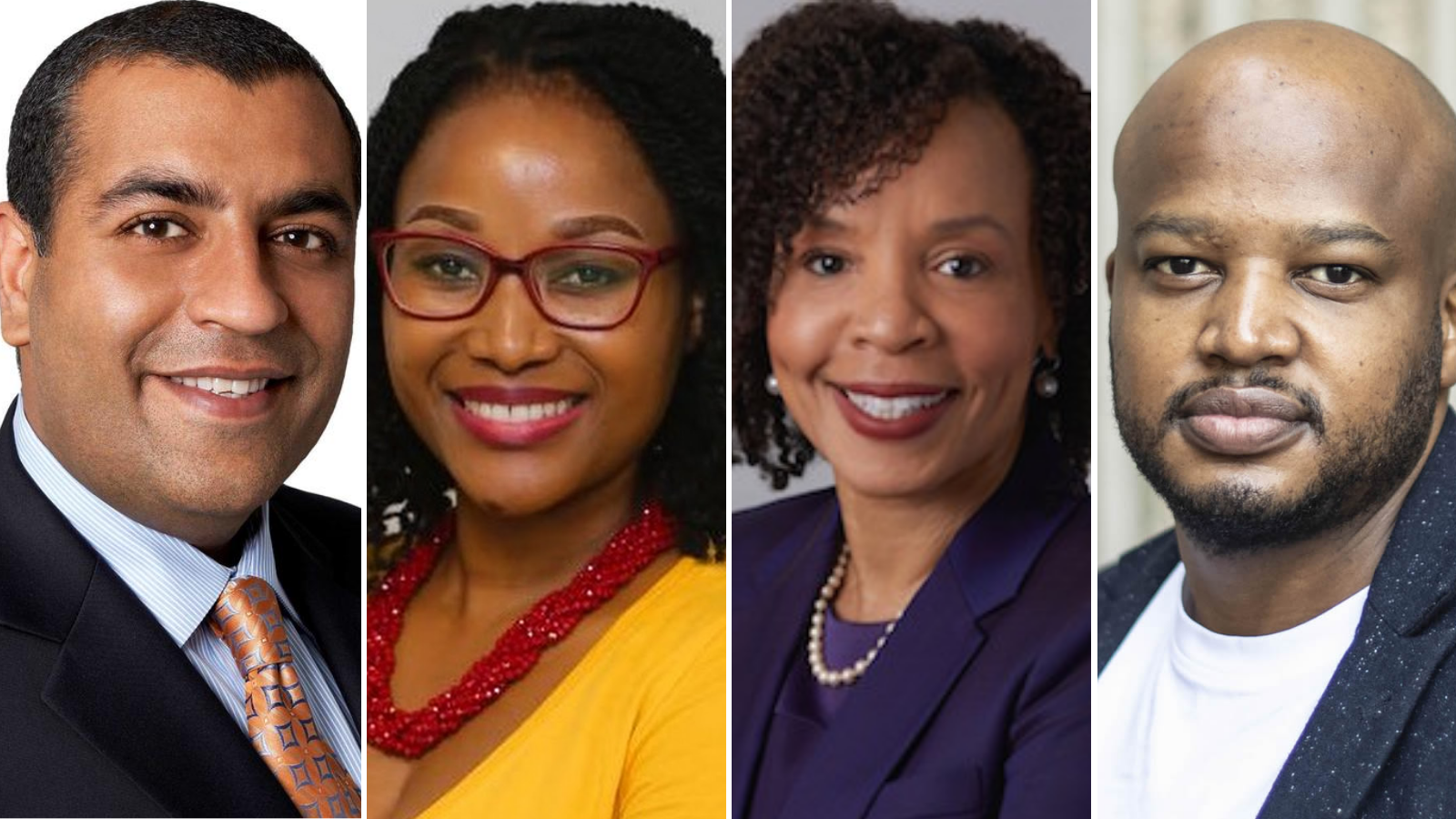In this piece
Race and leadership in the news media 2022: evidence from five markets

Neeraj Khemlani from CBS News, Nwabisa Makunga from the 'Sowetan', Kimberly Godwin from ABC News and Ron Derby from the 'Mail & Guardian'
In this piece
Key findings | General Overview | Methods and Data | Findings | Conclusion | Footnotes | References | Acknowledgements | About the AuthorsDOI: 10.60625/risj-rzv0-0463
Key findings
In this Reuters Institute factsheet we analyse the percentage of non-white top editors in a strategic sample of 100 major online and offline news outlets in five different markets across four continents: Brazil, Germany, South Africa, the United Kingdom (UK), and the United States (US).
Looking at a sample of ten top online news outlets and ten top offline news outlets in each of these markets, we find:
- Overall, 21% of the 82 top editors across the 100 brands covered are non-white, despite the fact that, on average, 43% of the general population across all five countries are non-white. If we set aside South Africa and look at the four other countries covered, 8% of the top editors are non-white, compared with, on average, 31% of the general population.
- In Brazil, Germany, and the UK, as in 2021, none of the outlets in our sample have a non-white top editor. In the US, 33% of top editors are non-white, up from 18% in 2021, and in South Africa, 73% are non-white, up from 60% in 2021.
- In every single country covered, the percentage of non-white people in the general population is much higher than it is among top editors.
- In the four countries where data are available on the number of non-white journalists, there continues to be no simple relationship between the percentage of non-white journalists and the percentage of non-white top editors. In Brazil and the UK, there are fewer non-white top editors than there are non-white journalists. In South Africa and the US, there are more non-white top editors than non-white journalists.
- The share of internet news users who say that they read news from at least one major outlet with a non-white top editor ranges from 0% in Brazil, Germany, and the UK to 91% in South Africa.
General Overview
It matters both practically and symbolically who occupies top editorial positions in major news outlets. Top editors are key figures in the leadership and direction of newsrooms. They make important decisions every day, and their personal experiences will sometimes be among the factors that influence these decisions. They also matter for how news outlets, and the news media more broadly, are seen by the public (Duffy 2019). These premises are central to our ongoing work studying diversity in leadership in the news media, both from the perspective of gender (Eddy et al. 2022) and race (Robertson et al. 2021).
We continue that work on race and leadership here, documenting the profile of top editors to assess one aspect of how the news media industry is responding to ongoing conversations about racial justice, equity, and diversity in many countries. Continued public attention to how the news media handle race and ethnicity around the world – in the UK, for instance, in the wake of Meghan Markle raising the problem of racism in the media in a high-profile interview with Oprah Winfrey, and the widely criticised initial response from the Society of Editors (which was followed by a withdrawal of the response, and the resignation of the executive who had issued it) – has fuelled discussions around prioritising diversity in the newsroom. As part of these, some journalists are highlighting that the racial and ethnic composition of newsroom management can affect diversity in hiring, retention, and promotion as well as in news content itself, influencing editorial decision-making and attention to stories and experiences that reflect the communities news organisations serve (Arboine 2020; Childers 2020). All this underlines that who top editors are matters.
This short factsheet adds to important research by others working on race in the news media, including studies by professional groups – for example, the American Society of News Editors diversity survey, led most recently by Meredith Clark (2019); the Diversity in Journalism report in the UK commissioned by the National Council for the Training of Journalists (Spilsbury 2021); and the Diversity im deutschen Journalismus study by Neue deutschen Medienmacher*innen in Germany (Boytchev et al. 2020) – as well as work by a range of academics (e.g. Callison and Young 2019; Douglas 2021; Lück et al. 2020).
Methods and Data
Continuing our work from previous years (Nielsen et al. 2020; Robertson et al. 2021), we focus on top editorial leadership positions in a strategic sample of five markets. These countries have different demographics and histories of white imperialism, colonialism, and slavery. To get an overview of similarities and differences across markets, as well as any changes in leadership, we examine the same countries in 2022 as we did last year, namely South Africa from Africa; Germany and the UK from Europe; the US from North America; and Brazil from South America. To be able to leverage available data on the journalistic profession and on news and media use, we include five markets from those covered in Worlds of Journalism (Hanitzsch et al. 2019) and in the Reuters Institute Digital News Report 2021 (Newman et al. 2021). Where it is possible, we compare our findings to data on diversity in the journalistic profession (using Worlds of Journalism data collected between 2012 and 2016) and in the wider population (using the most recent census and other official data). However, data are not always available and comparisons not always possible, not only because of limited research, but also because of legal restrictions on collecting and retaining certain statistics on race (for instance in Germany).
Our approach is identical to that of previous years. In each market, we focused on the top ten offline (TV, print, and radio) and online news brands in terms of weekly usage, as measured in the 2021 Reuters Institute Digital News Report (Newman et al. 2021). Our focus on the most widely used offline and online brands means that some important outlets with non-white editors are not included in the sample (in the UK, for example, the Financial Times, edited by Roula Khalaf, is not in the sample). Because of changes in what the most widely used brands are, and our focus on the top ten offline and online brands, there has been some turnover in the specific brands included in the analysis: 89 of the 100 brands covered in 2021 are included in the analysis again this year, with 11 new brands included.
For each brand, we identified the top editor by checking their official webpages. The data were collected in February 2022. We looked for editor-in-chief or the nearest equivalent; for example, executive editor, or head of news for TV. The exact terminology varies from country to country and organisation to organisation, but in most cases it is possible to identify a single person. We refer to the individuals identified collectively as the top editors. It is important to note, of course, that this does not mean the top editor is the only person who matters or, in fact, is the most important person in terms of day-to-day editorial decision-making. We coded observations as missing in cases where both online and offline versions of the same brand share a top editor, so the analysis covers a total of 82 individuals across the 100 brands included in 2022, compared with 80 individuals in 2021. Some top editors were stepping down at or around the time of data collection, such as Phathiswa Magopeni with SABC News in South Africa. In these cases where no replacement had been announced by late February 2022, we chose to keep the outgoing top editor listed as is. We include here the top editor as of late February.
The individuals identified were double-checked by journalists from the market in question, as well as by academic partners and our researchers. In some cases, we also contacted the brands or their press offices to confirm who their top editor was. Where organisations responded, we always deferred to their judgement. In a few cases, where an organisation has not responded to our query and where there is no single clearly designated editor-in-chief, or where roles and responsibilities across online and offline parts of the same outlet are unclear, we have made a judgement call as to who to code as the top editor of the outlet in question.
Following work on the representation of race in editorial positions in communications research (Chakravartty et al. 2018), we operationalised race by adopting a conceptualisation that contrasts institutionally dominant white populations and dominated non-white populations. This is the same approach we have used in previous years, and as in the past, we want to be clear: race and racial discrimination work in complex ways not always tied to skin colour, for example where it has a religious dimension. There are also dimensions of ethnicity that are not always related to conceptions of race. However, a white/non-white conceptualisation captures some important aspects of this in the countries we cover. We therefore deploy a simple and reductionist, but hopefully still illuminating and relevant, binary, and code each top editor as white or non-white. Non-white is in no way meant to suggest an identity, let alone a homogeneous group, given the great diversity and complexity of people’s identities, but it provides a way to categorise otherwise very different people who come from institutionally dominated ethnic and racial groups. It helps us point to a dimension of inequality in representation at a macro level.
All individuals in the dataset were coded independently by the authors. Race and ethnicity are complicated phenomena, and so are statistics on race and ethnicity. What we present here is based on our coding of the individuals covered. Top editors may not in every instance see themselves in the same way, or always be seen by everyone else in the same way. All the numbers presented here, both from our own data collection and from secondary sources we rely on, should be seen with this in mind.
Findings
Based on this dataset, we find that 21% of the 82 top editors across the 100 brands covered are non-white. This compares to 15% in 2021 and 18% in 2020. As in previous years, it is substantially below the, on average, 43% of people in the general population across all five markets who identify as non-white (based on census data and other official estimates).1 It is also below the average percentage of non-white journalists (21%) in the four countries where we have available data (Hanitzsch et al. 2019). Setting aside South Africa, 8% of top editors across Brazil, Germany, the UK, and the US are non-white, compared with, on average, 31% of the general population across these markets.
Looking exclusively at the 89 brands we covered in both 2021 and 2022, 22% of the top editors are non-white in 2022, compared with 17% in 2021. This reflects the fact that there has been some turnover among the top editors. Among the 16 new top editors identified and coded among these brands, six are non-white: three from South Africa, and three from the United States. (In the United States, there is now gender equity of non-white top leadership, with 50% men and 50% women among all non-white top editors coded in the sample – an important aspect due to the need to consider intersectional issues of structural inequality: Jackson et al. 2020).
As is clear from Figure 1, the percentage of non-white editors varies considerably across the five markets we cover. In Brazil, Germany, and the UK, as was the case in 2021, none of the outlets we cover has a non-white top editor. South Africa still has a majority of non-white top editors, up to 73% this year (from 60% in 2021). In the US, there are three more non-white top editors in our sample this year, bringing the percentage of non-white editors up to 33% (from 18% in 2021).
Figure 1.
When we look at the relationship between the percentage of non-white people working in journalism – relying on data from Worlds of Journalism collected between 2012 and 2016 (Hanitzsch et al. 2019) – and the percentage of non-white top editors across four of our five markets, shown in Figure 2, we find a mixed picture, as we have in previous years. (Data on the racial identity of journalists in Germany is not available.) The UK has a small number of non-white journalists (6%) and, again, no non-white top editors in our sample. The US also has a small number of non-white journalists (9%), but a larger percentage of non-white top editors (33%). In Brazil, despite a third of journalists being non-white (34%), there are no non-white top editors in our sample this year. South Africa stands out as an exception, with a third of journalists being non-white (34%) but 73% of top editors being non-white.
 Figure 2.
Figure 2.
In Figure 3, we plot data on the demographics of the population as a whole and the percentage of non-white top editors in each market. As in previous years, we find marked disparities. Well over half of the population in Brazil identifies as non-white (57%), but there are no non-white top editors in our sample. Germany and the UK have smaller percentages of non-white people in the general population, and no non-white top editors. In the US, the percentage of non-white top editors (33%) is still below the percentage of non-white (including Hispanic/Latinx) people in the general population (42%). And even South Africa, where the percentage of non-white people in the general population is 92%, has a disparity in representation among top editors (73% are non-white). While the gap has shrunk in both South Africa and the US, there continue to be significant disparities in representation among top editors – and in three markets with millions of non-white citizens, there continue to be no non-white top editors at all.
Figure 3.
Finally, by combining the data collected for this Reuters Institute factsheet with data from the 2021 Reuters Institute Digital News Report (Newman et al. 2021), we can identify the proportion of people in each market who access news from at least one major news outlet with a non-white top editor. In Figure 4, we show the share of online news consumers who say that they got news from at least one major outlet (online or offline) with a non-white top editor. The numbers vary considerably from country to country, with limited variation from 2021 to 2022. Audiences in Brazil, Germany, and the UK still accessed no news from a major outlet included in our sample and edited by a non-white person in the past week, for the simple reason that there are no non-white top editors among the outlets we cover. In the US, in 2022, 52% of online news users used at least one source with a non-white top editor, up from 42% in 2021, and in South Africa, that figure is 91%, up from 86%.
Figure 4.
Conclusion
In this Reuters Institute factsheet we have analysed the racial breakdown of top editors at a strategic sample of 100 major online and offline news outlets in five different markets across four continents. In a year in which many journalists and citizens continue to call for the news media to reckon with historical and current structural inequalities, including around race and racism, we find an increase in the number of non-white top editors in two of the countries covered. But it continues to be the case that there are no non-white top editors in our sample of brands in three other countries.
Overall, as in previous years, we find that white people are significantly over-represented among top editors relative to their share of the general population in all five countries, and non-white people are significantly under-represented.
Some individual news organisations clearly see this as a problem. As the USA Today writes in its annually updated diversity and inclusion data report, ‘we must build and sustain a workforce that is reflective of the diversity in the communities we serve’.2 It is also clear that many leaders in news media recognise that the industry as a whole, and many individual organisations, fall short of this aspiration. Among those surveyed in one recent study, only 38% of senior industry leaders said they felt their organisation was doing a good job in terms of ethnic diversity, and addressing a lack of ethnic diversity in their organisations was identified as the single most important priority in terms of improving diversity by a plurality of respondents (Cherubini et al. 2021).
Whether the industry as a whole delivers on this priority when it comes to top editors is something we will examine again when we repeat this analysis in 2023, as we continue to track developments in race and equality among top editors across the world.
Footnotes
References
- Arboine, N. 2020. ‘I’m a Black Journalist in the UK. That Simple Fact Still Makes Me Unusual’, Guardian. (accessed Mar. 2022).
- Boytchev, H., Horz, C., and Neumüller, M. 2020. Viel Wille, kein Weg: Diversity im deutschen Journalismus. Cologne: Neuen deutschen Medienmacher*innen.
- Callison, C., and Young, M. L. 2019. Reckoning: Journalism’s Limits and Possibilities. Oxford: Oxford University Press.
- Chakravartty, P., Kuo, R., Grubbs, V., and McIlwain, C. 2018. ‘#CommunicationSoWhite’, Journal of Communication, 68(2), 254–66.
- Cherubini, F., Newman, N., and Nielsen, R. K. 2021. Changing Newsrooms 2021: Hybrid Working and Improving Diversity Remain Twin Challenges for Publishers. Oxford: Reuters Institute for the Study of Journalism.
- Childers, N. 2020. ‘The Moral Argument for Diversity in Newsrooms is Also a Business Argument – and you Need Both’, NiemanLab. (accessed Mar. 2022).
- Clark, M. D. 2019. ‘ASNE Newsroom Diversity Survey’, News Leaders Association. (accessed Feb. 2022).
- Douglas, O. 2021. ‘The Media Diversity and Inclusion Paradox: Experiences of Black and Brown Journalists in Mainstream British News Institutions’, Journalism, March.
- Duffy, A. 2019. ‘Out of the Shadows: The Editor as a Defining Characteristic of Journalism’, Journalism.
- Eddy, K., Selva, M., and Nielsen, R. K. 2022. Women and Leadership in the News Media 2022: Evidence from Twelve Markets. Oxford: Reuters Institute for the Study of Journalism.
- Hanitzsch, T., Hanusch, F., Ramaprasad, J., and de Beer, A. S. (eds). 2019. Worlds of Journalism: Journalistic Cultures around the Globe. New York: Columbia University Press.
- Jackson, S. J., Bailey, M., and Welles, B. F. 2020. #HashtagActivism: Networks of Race and Gender Justice. Cambridge, MA: MIT Press.
- Lück, J., Schultz, T., Simon, F., Borchardt, A., and Kieslich, S. 2020. ‘Diversity in British, Swedish, and German Newsrooms: Problem Awareness, Measures, and Achievements’, Journalism Practice.
- Newman, N., Fletcher, R., Schulz, A., Andı, Reuters Institute Digital News Report 2021. Oxford: Reuters Institute for the Study of Journalism.
- S., Robertson, C. T., and Nielsen, R. K. 2021. Nielsen, R. K., Selva, M., and Andı, S. 2020. Race and Leadership in the News Media 2020: Evidence from Five Markets. Oxford: Reuters Institute for the Study of Journalism.
- Robertson, C. T., Selva, M., and Nielsen, R. K. 2021. Race and Leadership in the News Media 2021: Evidence from Five Markets. Oxford: Reuters Institute for the Study of Journalism.
- Spilsbury, M. 2021. Diversity in Journalism. London: National Council for the Training of Journalists.
Acknowledgements
The authors would like to thank Anne Schulz, Caithlin Mercer, Camila Mont’Alverne, Luiz Boaventura Teixeira, and Nic Newman for their valuable time, input, and feedback.

This report can be reproduced under the Creative Commons licence CC BY. For more information please go to this link.
About the Authors
Kirsten Eddy is a Research Fellow at the Reuters Institute for the Study of Journalism.
Meera Selva is the Director of the Journalist Fellowship Programme and Deputy director at the Reuters Institute for the Study of Journalism.
Rasmus Kleis Nielsen is the Director of the Reuters Institute for the Study of Journalism and Professor of Political Communication at the University of Oxford.
In every email we send you'll find original reporting, evidence-based insights, online seminars and readings curated from 100s of sources - all in 5 minutes.
- Twice a week
- More than 20,000 people receive it
- Unsubscribe any time



